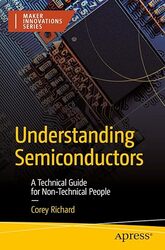
Rating: 7.8/10.
Understanding Semiconductors: A Technical Guide for Non-Technical People by Corey Richard
Fairly short book, about 200 pages, that covers the design and manufacturing of semiconductors, chips, and electronics. It is written at a high level and is not very technical, good to have some understanding of the trade-offs between different technology choices and a reasonable introduction to the topic for non-specialists.
Chapter 1. Electric current is electrons flowing in a conductor, and the amount is measured in amperes. Electric potential is a difference in charge measured in voltage. Voltage can be thought of as pushing electrons through a circuit, and the charge flows from high to low potential, opposite of the direction that the electrons flow. Power is measured in watts, which is the work that is done in a circuit, and it’s equal to the voltage times the current.
Semiconductors are materials that can be made to sometimes conduct and sometimes insulate, and they are usually made of silicon. In the semiconductor manufacturing process, first the market demand is evaluated, then the chip is designed, fabricated from wafers, and then packaged and integrated with other components in a circuit board. Fabless companies only focus on the chip design step and outsource all the other steps. There is a trade-off between several factors: power, performance, size, and cost.
Chapter 2. The major discrete components are the resistor, capacitor, transistor, diode, and inductor. Transistors allow or block electron flow from a source to a drain via a voltage gate being either high or low and is the basis for logic gates. Most transistors are Field Effect Transistors (FET), either MOSFET or FinFET, which has greater efficiency. Most chips are made using CMOS (Complementary Metal Oxide Semiconductor), and each generation of CMOS is more efficient and smaller (geometric scaling), and is measured in nanometer process, eg, 7nm process is the distance between the transistor source and the drain. Functional scaling is improving performance through better design rather than smaller transistors.
Chapter 3. A system consists of several levels: level 1 is integrated circuits; level 2 is multiple ICs wrapped in an enclosure. Level 3 is PCB (printed circuit board), and level 4 is a fully functional system with multiple PCBs and peripherals. The design process begins when the system architect decides what they are trying to build and how. The front-end design is where engineers create the chip virtually using hardware description languages like Verilog. Design verification involves testing the virtual design using a combination of functional tests, emulation, and formal verification.
After the design has been verified, the backend design (synthesis) process begins, where the virtual design is turned into a physical design. Placement and routing determines the physical locations of all the components. Timing analysis ensures that there is enough time for the signal to propagate through the IC in all possible critical paths during one clock cycle, since otherwise the computation may be incorrect. The result of this physical design is a GDS file that is sent to the foundry for manufacturing.
Chapter 4. The chip manufacturing process starts with the silicon wafer, which is cut into hundreds of chips. Deposition uses gases to add a thin film layer onto the wafer, then photolithography uses light to etch multiple layers of patterns onto the wafer, and EUV technology is needed to add smaller features. The process of deposition, lithography, etching, and doping is repeated several dozen times to add multiple layers of structures onto the chip and takes several weeks. After the whole process, the chips undergo testing at wafer and chip levels to identify defects, and the yield (percentage of working chips) is important for profitability. Fabrication requires special clean rooms with air filtration systems and vibration control to improve the yield. Finally, the wafer is cut into chips, attached to a die package, and sealed before final testing.
Chapter 5. Mounting an IC onto a system: the simplest way to mount an IC is through wire bonding, with pins going externally from the chip, though this method supports only a limited number of pins. The flip chip packaging puts the pins on the lower side of the chip to be soldered with an array of balls. A system on package means that the package has multiple chips together to reduce the distance, and the dies may sometimes be stacked in 3D space.
Signal integrity aims to reduce noise and crosstalk where different signals bleed into each other. A bus interface transmits data between the CPU, memory, and I/O, and can be either parallel with multiple wires or serial with a single wire. Parallel tends to be faster but is limited to the number of bits that can be centered in a clock cycle. Power control components convert between AC and DC, regulate the voltage to be steady, and distribute the right voltage to different components.
Chapter 6: Signals can be analog or digital. Analog signals are continuous and typically used for sensors where frequency information is important, whereas digital signals are typically used for computing, use less power, and are less sensitive to noise. Microprocessors handle more general computing tasks than microcontrollers, which perform simpler operations, and digital signal processors handle real-time signal data and are used with analog-to-digital converters.
Application-specific chips may have varying degrees of specialization; they may have a specific function but can be used in multiple systems, or they may be circuit designs for use in a single system. The CPU has the core logic of a system and communicates data through registers, which is good for fast and complex operations, whereas the GPU is good at many simpler tasks in parallel. The ASIC (Application-Specific Integrated Circuit) is hardware designed for a specific application, and FPGA (Field-Programmable Gate Array) is hardware that can be reprogrammed, so it’s cheaper to develop, but ASICs are cheaper to produce at scale and are more efficient.
Some ASICs contain a CPU and other components like memory, radio, power management, and then they are SOC (System on a Chip). Memory is arranged in a hierarchy with the cache closest to the CPU that is faster and smaller, and RAM is volatile working memory, whereas ROM is larger but read-only non-volatile memory. Secondary memory includes HDD and SSD, which uses flash memory that is more expensive but faster than HDD. Die stacking has resulted in higher memory density. Sensors detect physical inputs and can turn them into signals, whereas actuators turn signals into physical outputs. Some sensors contain mechanical parts and are called MEMS (Micro-electromechanical systems).
Chapter 7: RF (Radio Frequency) signals are analog waves must transmit in strict frequency bands, as regulated by the FCC, in order to avoid interfering with each other. Components of a radio system include an oscillator (generates a wave from a power source), modulator and demodulator (converts between digital signals and waveforms); during receiving, filters are used after the antenna receives signals to remove noise. A cellular connection first connects to a nearby base station that covers a few miles before being routed to its destination. Multiple signals are handled simultaneously through TDMA (temporal multiplexing) and CDMA (frequency channel multiplexing).
Chapter 8: Two macroarchitectures are the Harvard architecture which has separate address spaces for data (RAM) and program instructions (ROM), whereas the von Neumann architecture combines them into a single address space for both, which is a lot more common. Instruction Set Architecture (ISA) defines the instructions that a processor can support for software, and microarchitecture determines how these instructions are implemented. The clock frequency is the number of clock cycles per second, and a complex instruction is broken down into several pieces that each take one clock cycle so the instruction can be pipelined and a component can process the next instruction in parallel. An ISA can be reduced (RISC) or complex (CISC), with RISC being more popular since it is easier for compilers and pipelining. There is a trade-off between integrating different components at a circuit board level, which is lower cost and faster to produce, versus integrating them in the same chip, which maximizes performance.
Chapter 9. Both the design and manufacturing of chips have become much more complex, leading to specialization. Early players like Fairchild Semiconductor did both design and manufacturing, but these have now specialized to varying degrees – most companies are now either fabless companies that do pure design like Qualcomm, which are based in the US, while manufacturing foundry specialists like TSMC are based in Asia.
Some exceptions are integrated device manufacturers (IDMs) like Intel that both design and manufacture chips. There are pros and cons to this approach: the advantages are tighter integration and greater control, but these are outweighed by many disadvantages: they can’t pool demand to fully utilize capacity, and delays in fab development affect the whole product. The technology is often behind compared to pure foundries, and the issue of integration is less of a concern now with compatible technologies.
Regarding the economics of semiconductor manufacturing, the industry has seen high growth in sales and productivity, workers’ salaries compared to other manufacturing industries. Projects are highly capital intensive, and there is a high degree of consolidation within each category to a few players. The US maintains its lead in chip design primarily due to its talent pool, whereas Asian countries dominate manufacturing because of lower labor costs and government investment. Many parts of the supply chain are highly consolidated, leading to an inability to respond quickly to changes in demand, eg, during COVID-19, the car chip shortage occurred due to a misprediction in demand and the inability to adjust production quickly. This consolidation is susceptible to local and geopolitical risks, leading governments to attempt to intervene; China is trying to catch up but remains quite behind technologically.
Chapter 10: a brief discussion on speculative future technologies, such as techniques to enable denser die stacking, improved types of transistors, quantum computing, etc.



